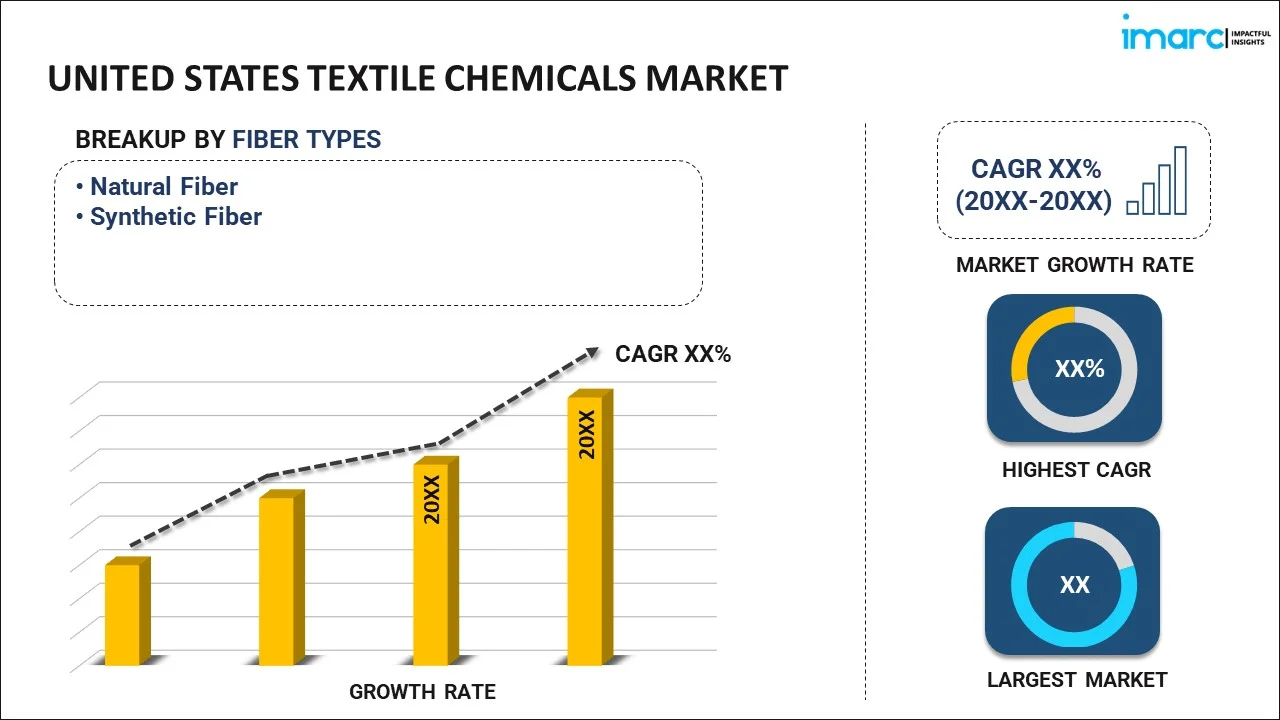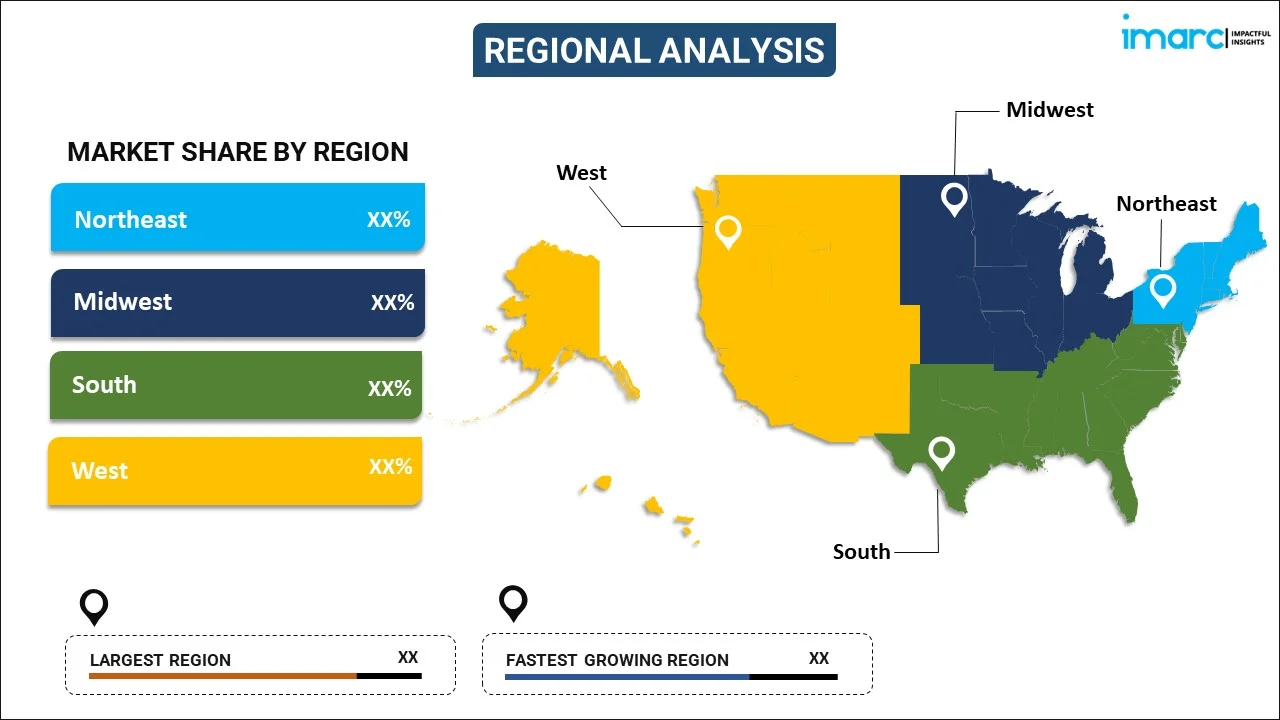
United States Textile Chemicals Market Report by Fiber Type (Natural Fiber, Synthetic Fiber), Product Type (Coating and Sizing Chemicals, Finishing Agents, Colorants and Auxiliaries, Surfactants, Desizing Agents, and Others), Application (Home Furnishing, Apparels, Industrial Textile, Automotive Textile, and Others), and Region 2024-2032
Market Overview:
United States textile chemicals market size is projected to exhibit a growth rate (CAGR) of 4.00% during 2024-2032. The growing demand for durable and long-lasting clothing, rising focus on eco-friendly and bio-based textile chemicals, and increasing need for chemicals to achieve softness and color vibrancy in bedding and upholstery represent some of the key factors driving the market.
|
Report Attribute
|
Key Statistics
|
|---|---|
|
Base Year
|
2023 |
|
Forecast Years
|
2024-2032
|
|
Historical Years
|
2018-2023
|
| Market Growth Rate (2024-2032) | 4.00% |
Textile chemicals are specialized chemical compounds used to enhance and improve various aspects of textile production and fabric quality. They comprise a wide range of substances, such as dyes, finishing agents, auxiliaries, and coatings, each serving a specific purpose in the textile production process. They play a crucial role in the manufacturing process, helping to achieve desired characteristics in textiles, such as color vibrancy, durability, softness, and resistance to factors like water, fire, and ultraviolet (UV) rays. They are added to textiles to reduce their flammability, making them safer in applications where fire resistance is critical. They can provide softness, wrinkle resistance, water repellency, and improve the overall appearance of textiles. They also deliver a clean white finish to the fabrics by applying optical brightening agents (OBA) of blue, violet, and red tints. They ensure enhanced dye absorption and adhesion, resulting in uniform and consistent coloring. They inhibit the growth of microorganisms on textiles, which makes them suitable for applications where hygiene is essential. They assist in producing high-quality fabrics and finished products that meet the unique demands of individuals and industry standards. As they aid in producing functional textiles with specific properties, such as moisture management, odor control, and conductivity, the demand for textile chemicals is rising in the United States.
United States Textile Chemicals Market Trends:
At present, the escalating demand for textile chemicals, as they improve the durability and longevity of textiles by enhancing colorfastness and resistance to wear and tear, represents one of the major factors influencing the market positively in the United States. Additionally, increasing preferences for sustainable textiles is impelling the growth of the market in the country. Apart from this, there is a rise in the demand for flame retardant chemicals in textile materials, especially in the construction sector. This, coupled with the growing adoption of textiles with ultraviolet (UV) protection, is offering a positive market outlook in the country. Moreover, the increasing focus on eco-friendly and bio-based textile chemicals is bolstering the growth of the market. In line with this, advancements in textile technology are leading to the development of smart textiles with conductive and functional additives, which is strengthening the market growth in the US. Furthermore, the rising employment of repellent chemicals to prevent stains is providing lucrative growth opportunities to industry investors. In addition, the increasing employment of textile chemicals to achieve softness and color vibrancy in bedding and upholstery is contributing to the market growth in the country. The rising need for moisture management and odor control chemicals in sportswear and activewear is also supporting the growth of the market in the US.
United States Textile Chemicals Market Segmentation:
IMARC Group provides an analysis of the key trends in each segment of the market, along with forecasts at the country level for 2024-2032. Our report has categorized the market based on fiber type, product type, and application.
Fiber Type Insights:

- Natural Fiber
- Synthetic Fiber
The report has provided a detailed breakup and analysis of the market based on the fiber type. This includes natural fiber and synthetic fiber.
Product Type Insights:
- Coating and Sizing Chemicals
- Finishing Agents
- Colorants and Auxiliaries
- Surfactants
- Desizing Agents
- Others
A detailed breakup and analysis of the market based on the product type have also been provided in the report. This includes coating and sizing chemicals, finishing agents, colorants and auxiliaries, surfactants, desizing agents, and others.
Application Insights:
- Home Furnishing
- Apparels
- Industrial Textile
- Automotive Textile
- Others
The report has provided a detailed breakup and analysis of the market based on the application. This includes home furnishing, apparels, industrial textile, automotive textile, and others.
Regional Insights:

- Northeast
- Midwest
- South
- West
The report has also provided a comprehensive analysis of all the major regional markets, which include Northeast, Midwest, South, and West.
Competitive Landscape:
The market research report has also provided a comprehensive analysis of the competitive landscape. Competitive analysis such as market structure, key player positioning, top winning strategies, competitive dashboard, and company evaluation quadrant has been covered in the report. Also, detailed profiles of all major companies have been provided. Some of the key players include:
- American Textile LLC
- Archroma U.S. Inc
- BASF SE
- Brenntag North America Inc.
- Lubrizol corporation
- The Dow Chemical Company
(Please note that this is only a partial list of the key players, and the complete list is provided in the report.)
United States Textile Chemicals Market Report Coverage:
| Report Features | Details |
|---|---|
| Base Year of the Analysis | 2023 |
| Historical Period | 2018-2023 |
| Forecast Period | 2024-2032 |
| Units | US$ Million |
| Scope of the Report | Exploration of Historical and Forecast Trends, Industry Catalysts and Challenges, Segment-Wise Historical and Predictive Market Assessment:
|
| Fiber Types Covered | Natural Fiber, Synthetic Fiber |
| Product Types Covered | Coating and Sizing Chemicals, Finishing Agents, Colorants and Auxiliaries, Surfactants, Desizing Agents, Others |
| Applications Covered | Home Furnishing, Apparels, Industrial Textile, Automotive Textile, Others |
| Regions Covered | Northeast, Midwest, South, West |
| Companies Covered | American Textile LLC, Archroma U.S. Inc, BASF SE, Brenntag North America Inc., Lubrizol corporation, The Dow Chemical Company, etc. (Please note that this is only a partial list of the key players, and the complete list is provided in the report.) |
| Customization Scope | 10% Free Customization |
| Report Price and Purchase Option | Single User License: US$ 3699 Five User License: US$ 4699 Corporate License: US$ 5699 |
|
Post-Sale Analyst Support |
10-12 Weeks |
| Delivery Format | PDF and Excel through Email (We can also provide the editable version of the report in PPT/Word format on special request) |
Key Questions Answered in This Report:
- How has the United States textile chemicals market performed so far and how will it perform in the coming years?
- What has been the impact of COVID-19 on the United States textile chemicals market?
- What is the breakup of the United States textile chemicals market on the basis of fiber type?
- What is the breakup of the United States textile chemicals market on the basis of product type?
- What is the breakup of the United States textile chemicals market on the basis of application?
- What are the various stages in the value chain of the United States textile chemicals market?
- What are the key driving factors and challenges in the United States textile chemicals?
- What is the structure of the United States textile chemicals market and who are the key players?
- What is the degree of competition in the United States textile chemicals market?
Key Benefits for Stakeholders:
- IMARC’s industry report offers a comprehensive quantitative analysis of various market segments, historical and current market trends, market forecasts, and dynamics of the United States textile chemicals market from 2018-2032.
- The research report provides the latest information on the market drivers, challenges, and opportunities in the United States textile chemicals market.
- Porter's five forces analysis assist stakeholders in assessing the impact of new entrants, competitive rivalry, supplier power, buyer power, and the threat of substitution. It helps stakeholders to analyze the level of competition within the United States textile chemicals industry and its attractiveness.
- Competitive landscape allows stakeholders to understand their competitive environment and provides an insight into the current positions of key players in the market.
Need more help?
- Speak to our experienced analysts for insights on the current market scenarios.
- Include additional segments and countries to customize the report as per your requirement.
- Gain an unparalleled competitive advantage in your domain by understanding how to utilize the report and positively impacting your operations and revenue.
- For further assistance, please connect with our analysts.
 Inquire Before Buying
Inquire Before Buying
 Speak to an Analyst
Speak to an Analyst
 Request Brochure
Request Brochure
 Request Customization
Request Customization




.webp)




.webp)












